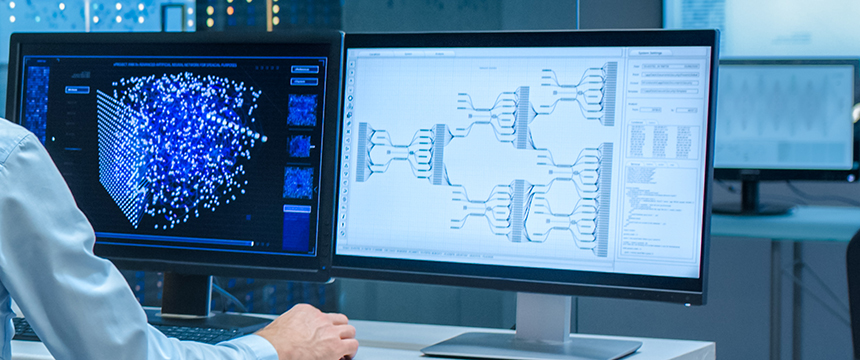Building A Technological Moat: Strategic Use of Continuing Patent Applications

For technology-focused companies that rely heavily on innovation, patent portfolio development is critical for establishing and expanding their competitive edge. A key for strategic portfolio development is the continuation application, which provides the ability to continually expand protection and set up coverage over competitors using the concepts described in existing applications. Having a well-developed patent portfolio can provide long-term revenue to a company through licensing, assist in obtaining funding, and help establish a technological moat around the company’s proprietary technology.
This article outlines reasons why companies pursue these types of applications and highlights tactical considerations to implement for yielding a well-developed patent portfolio.
Continuing Application Basics
Patent rights are defined by the scope of your claims. The process of obtaining a patent covering an invention typically goes as follows:
- Applicant confers with a patent attorney to describe the invention;
- Patent attorney drafts and files patent application, which includes intended claim scope for covering the invention;
- Patent Office reviews patent application and provides closest prior art;
- If prior art reads on the claims in patent application, patent attorney may propose narrowing the claim scope; or
- If prior art does not cover claims in patent application, Patent Office issues a notice of allowance, indicating their intent to grant the patent application.
The Applicant has the opportunity to file a Continuing Application during the “pendency” of the patent application (e.g., until the patent application grants). Pursuing any Continuing Application comes with inherent costs, which includes cost for preparing the Continuing Application, Patent Office fees, and costs for the “back-and-forth” with the Patent Office to obtain patent coverage. Additionally, maintenance fees for the granted patent are due at various intervals (3.5 years, 7.5 years, and 11.5 years from grant), to keep the patent “alive” and in force. However, filing a Continuing Application does not change the fact that a company has been granted patent rights which are enforceable – it merely permits the company an additional bite at the apple. There are primarily two types of continuing applications, which serve different purposes.
One type of continuing application is referred to as a Divisional Application. To provide some context, as part of the Patent Office’s review at step 3(a) outlined above, the Patent Office may determine that the claim scope presented in the patent application covers separate and distinct inventions. In these instances, the Patent Office issues a notice which requests the Applicant to select claims covering one of the inventions which the Patent Office should search and provide the closest prior art. Divisional Applications are filed to pursue claims covering the “other” invention(s) which were not searched by the Patent Office. As such, these types of applications are prompted by the Patent Office’s review of the patent application and claims.
In contrast to Divisional Applications described above, which are prompted by the notice from the Patent Office, Continuation Applications are more of a catch-all and can serve several different purposes. Some Applicants file Continuation Applications to pursue alternative inventions or implementations which were not pursued in the first application. Take, for instance, a patent application which describes in detail an automobile and the sum of its parts, and presents claims covering an engine of the automobile. In this example, an Applicant may file one Continuation Application covering the chassis, another Continuation Application covering the seats, and another Continuation Application covering the infotainment system. All of these applications would be supported by the original filing but cover different features. Some Applicants file Continuation Applications to pursue broader claim scope than what was determined to be allowable by the Patent Office. Continuing the above example, an Applicant may file claims that are still covering the engine, though using broader language.
Some advantages are the same for any type of Continuing Application – by maintaining the pendency of an application, an Applicant can mine the application for additional features that can be protected down the road as implementation details shift. Additionally, the more granted and enforceable patent coverage that a company has in a patent portfolio, the more likely competitors will be amenable to licensing the patent portfolio. For instance, a competitor may be less concerned about a one-off patent covering one particular facet that can easily be designed around, than a minefield of patents which disrupt business processes as the competitor goes to market. This result can yield revenue to the company directly from competitors while avoiding disruptive and costly patent litigation.
Reasons for Pursuing Alternative Coverage Continuation Applications
Part of the process of filing an initial application – perhaps covering foundational technology – involves considering alternative implementation details. Often times an initial application covering foundational technology may be considered an “omnibus application,” which covers an entire product or service offering. When determining claim scope, the Applicant will focus on features which are deemed most commercially relevant at the time of filing. This can be a moving target, however, as the product roadmap changes. By pursuing alternative coverage Continuation Applications, Applicants can hit the moving target by focusing new claim sets on features which are described in the patent application but not necessarily claimed.
Additionally, depending on the nature of the invention described in the patent application, it can be challenging to get broad claim coverage on the entirety of the system. However, protecting individual features or elements which are higher priority, and subsequently filing Continuation Applications on other features or elements can result in a technological moat around the entirety of the system. By protecting each of the individual parts, eventually an applicant protects the sum of the parts – or the whole system. Furthermore, by prioritizing features or elements for earlier protection and postponing – though describing – medium to low priority features or elements, a company can more easily manage legal spend.
Reasons for Pursuing Broadening Continuation Applications
One advantage of pursuing a broadening Continuation Application is that the Applicant receives a second search of the invention. By pursuing broader claim coverage in a Continuation Application, the Patent Office essentially repeats the process performed for the first application. This provides a second (broader) search of the prior art. Seemingly, after two thorough searches (potentially by two different examiners), the Applicant is made aware of the best prior art in the space. Assuming the Applicant obtains the broader claim coverage, the patent claims may be considered “stronger” in that they have undergone more thorough examination by the Patent Office. Additionally, by having the second search, if the Patent Office identifies more relevant art that was inadvertently missed in the first search, the Applicant can amend the claim scope in the Continuation Application to ensure that their claims are valid over the more relevant art, and could reevaluate maintaining the granted patent in view of the art. This would reduce overall legal spend by ensuring that only valid patents are maintained by the Applicant. Additionally, there can be some strategic advantages with the Patent Office by pursuing serial Continuation Applications having broader claim coverage. For instance, if the first application and Continuation Application are examined by the same patent examiner at the Patent Office, the examiner may be more prone to allow the Continuation Application so long as the features which were determined to be important for novelty are present in the claims of the Continuation Application. This can result in broader patent coverage while also reducing legal spend on the back-and-forth with the Patent Office.
Another advantage of pursuing a broadening Continuation Application is that the Applicant maintains the pendency of the concepts described in the first application. Maintaining the pendency of the concepts allows the Applicant to pursue different / broader claim scope for various purposes. First, as the Applicant commercializes their invention into a product or service, implementation details and designs of the invention often change. So long as the implementation details and alternative designs are described in the patent application, the Applicant may pursue claim scope which covers those details/designs. This would yield claim scope which covers the commercialized product, as opposed to prior designs which may now be obsolete in the eyes of the Applicant. Second, as competitors enter the marketplace, Applicants may pursue claim scope which reads on competitive offerings. This may provide tighter infringement positions with respect to the competitive offerings, effectively blocking competitors from ever entering the marketplace or disrupting competitive roll-outs as competitors attempt to enter the marketplace.
Conclusion
There are many ways in which a company can formulate a continuation intellectual property strategy based on a single patent application filing. However, the continuation intellectual property strategy should always take into consideration the company’s product roadmap, competitors, and prioritize features of the product roadmap which are differentiators. This will result in an effective way that the company can manage legal spend while still building their technological moat around their product.

